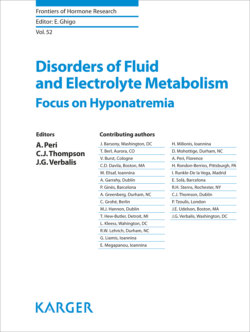Читать книгу Disorders of Fluid and Electrolyte Metabolism - Группа авторов - Страница 21
На сайте Литреса книга снята с продажи.
Determinants of Plasma Sodium Concentration
ОглавлениеIn 1958, Edelman et al. [4] demonstrated that the major determinants of plasma sodium concentration are total exchangeable body sodium, total exchangeable body potassium, and total body water. A simplified version of what has come to be known as the Edelman equation is:
where PNa is the sodium concentration in plasma water (in mmol/L), NaE is the total exchangeable body sodium (in mmol), KE is the total exchangeable body potassium (in mmol), and TBW is the total body water (in L).
Normal sodium concentration in whole plasma is 140 mmol/L. However, plasma is composed of aqueous (93%) and non-aqueous (7%) fractions. Sodium is present only in the aqueous fraction. Therefore, sodium concentration in plasma water is 140/0.93 or 150.5 mmol/L [3]. Total body sodium, measured by isotope dilution analysis, is made up of a pool that exchanges within 24 h and accounts for 70% of total body sodium. This pool is estimated at 40 mmol/kg [4], or 2,800 mmol in a 70 kg man. The nonexchangeable Na resides primarily in bone. When similarly measured, 85% of total body potassium is exchangeable, estimated at 53.3 mmol/kg [5], or 3,731 mmol in a 70 kg man. At a plasma water sodium concentration of 150.5 mmol/L such an individual would have 43.4 L of total body water (equation 2).
